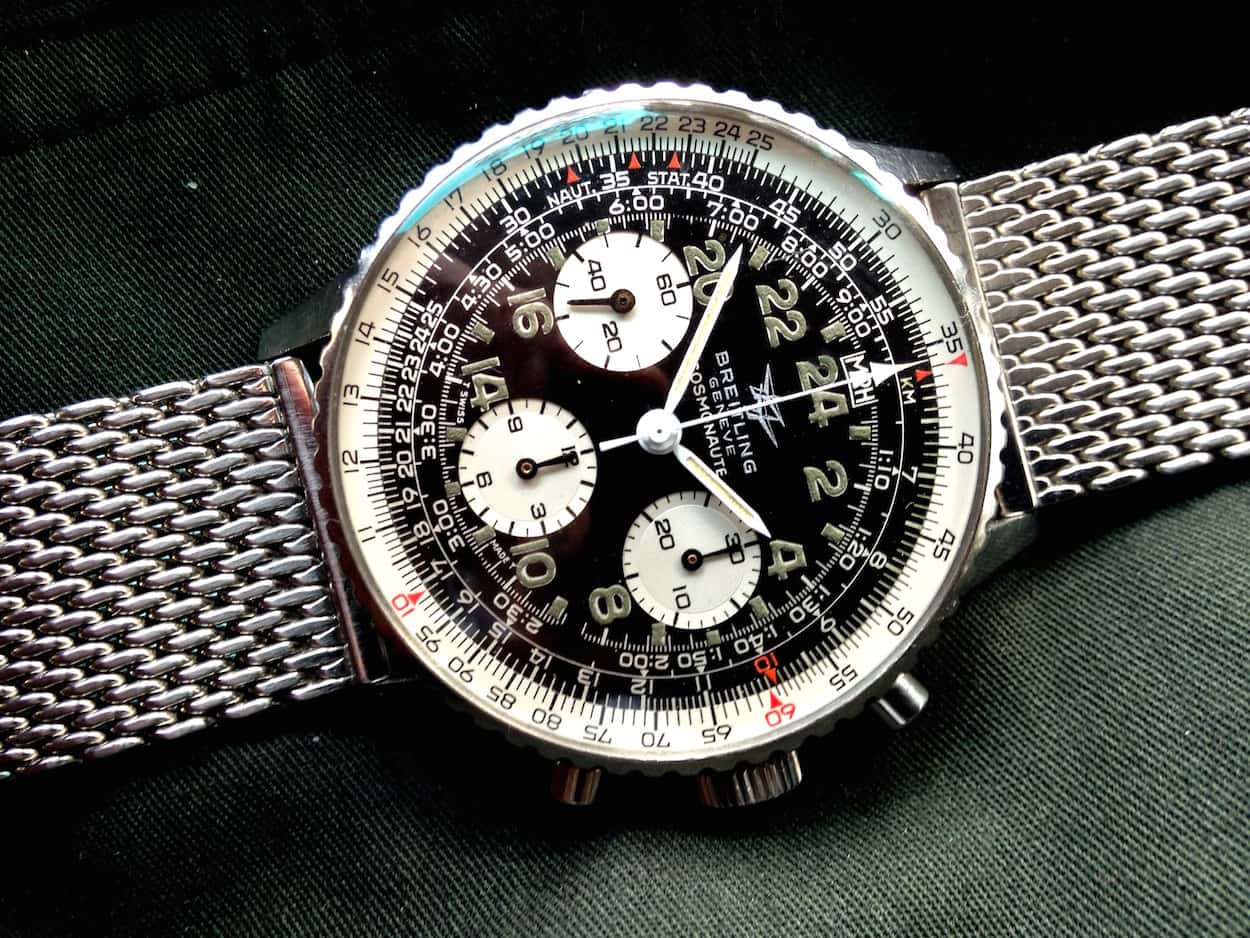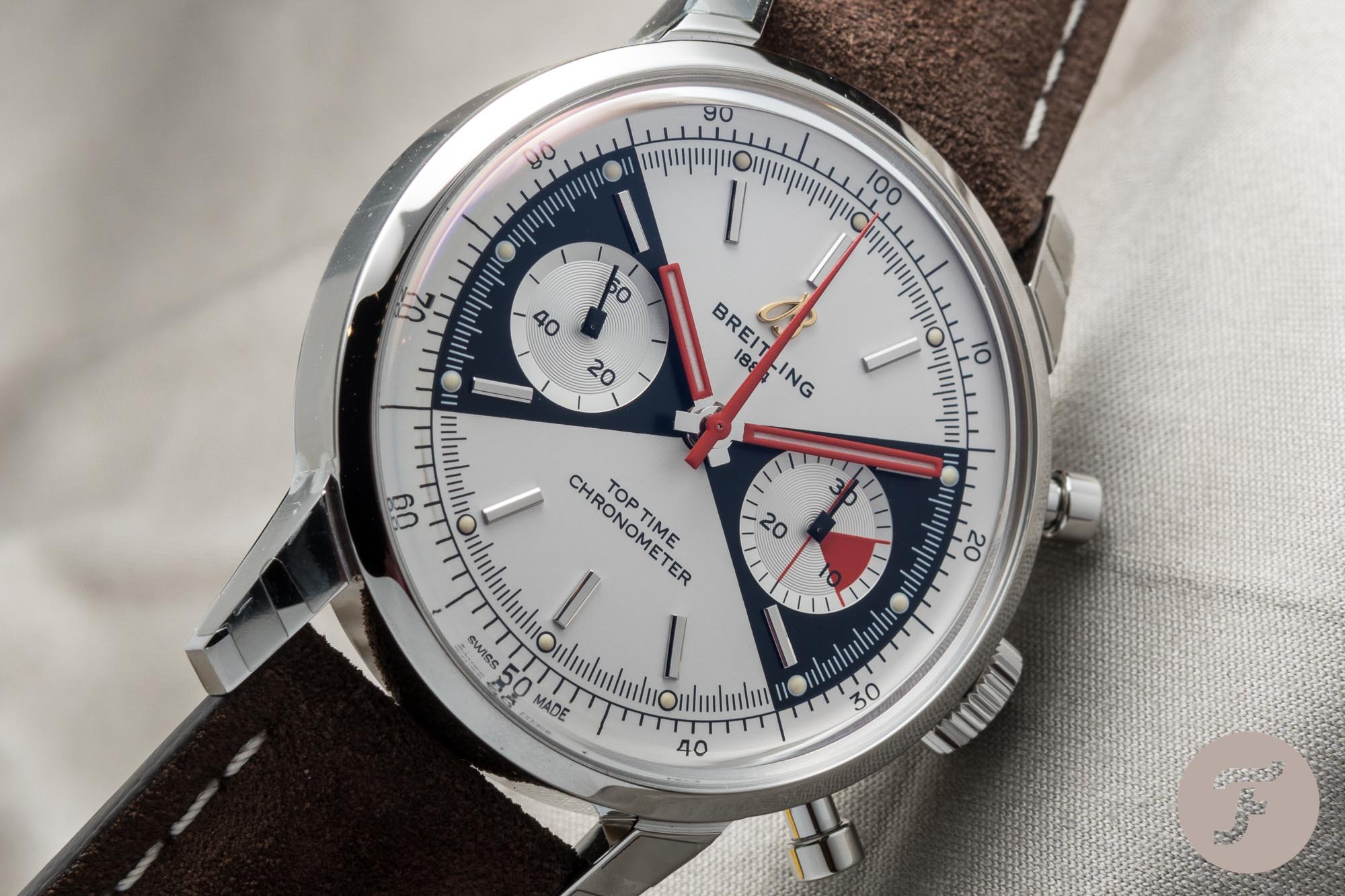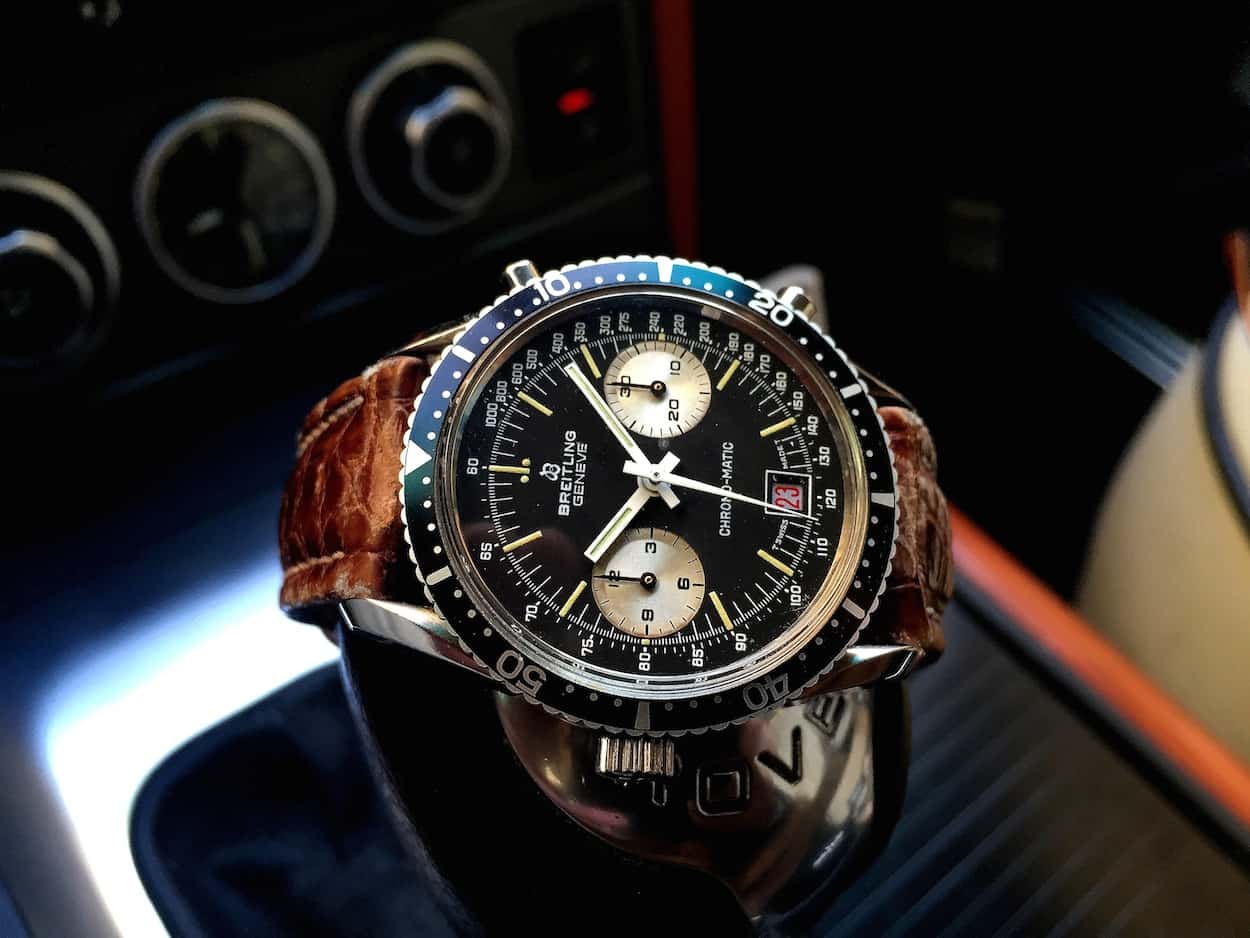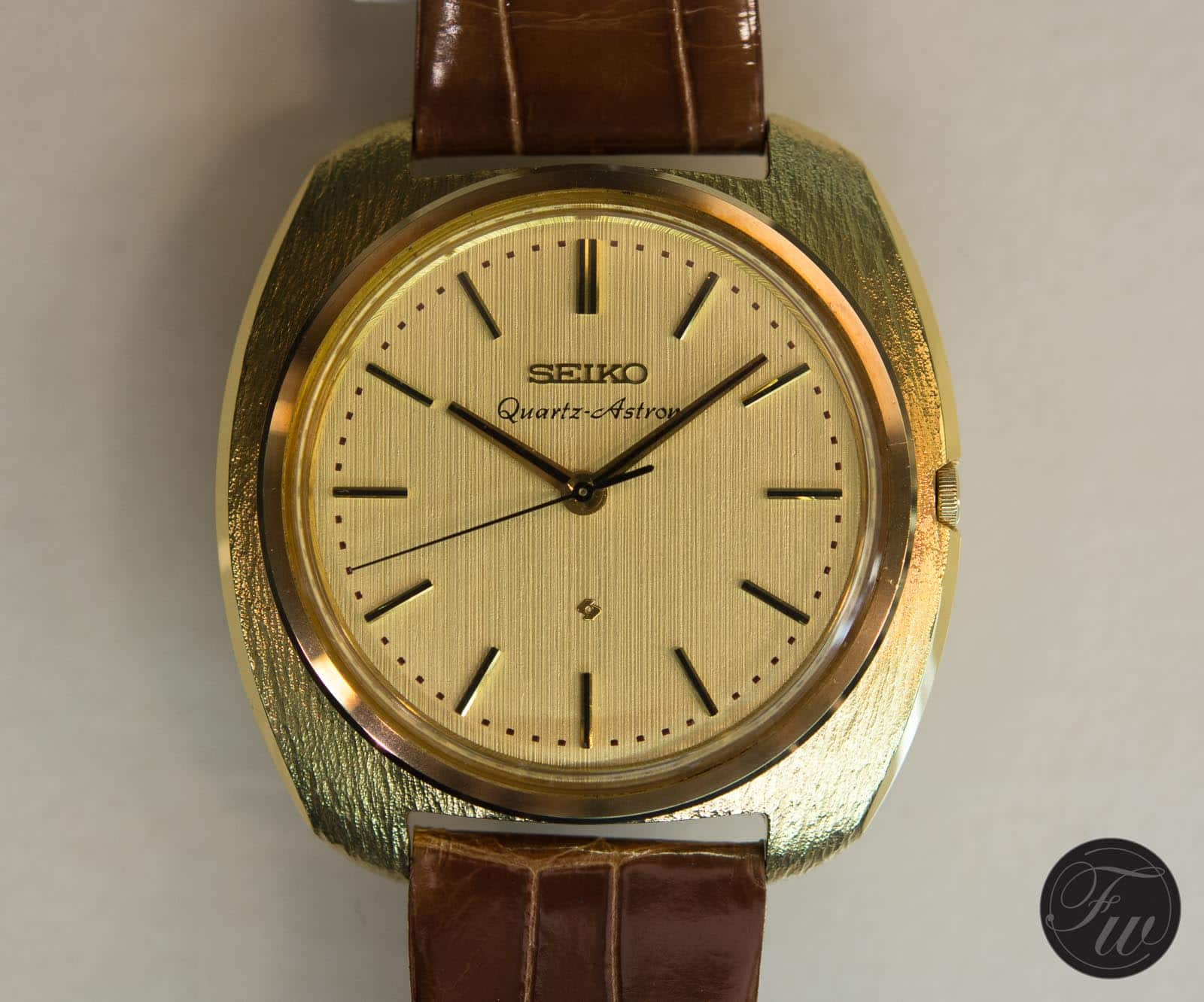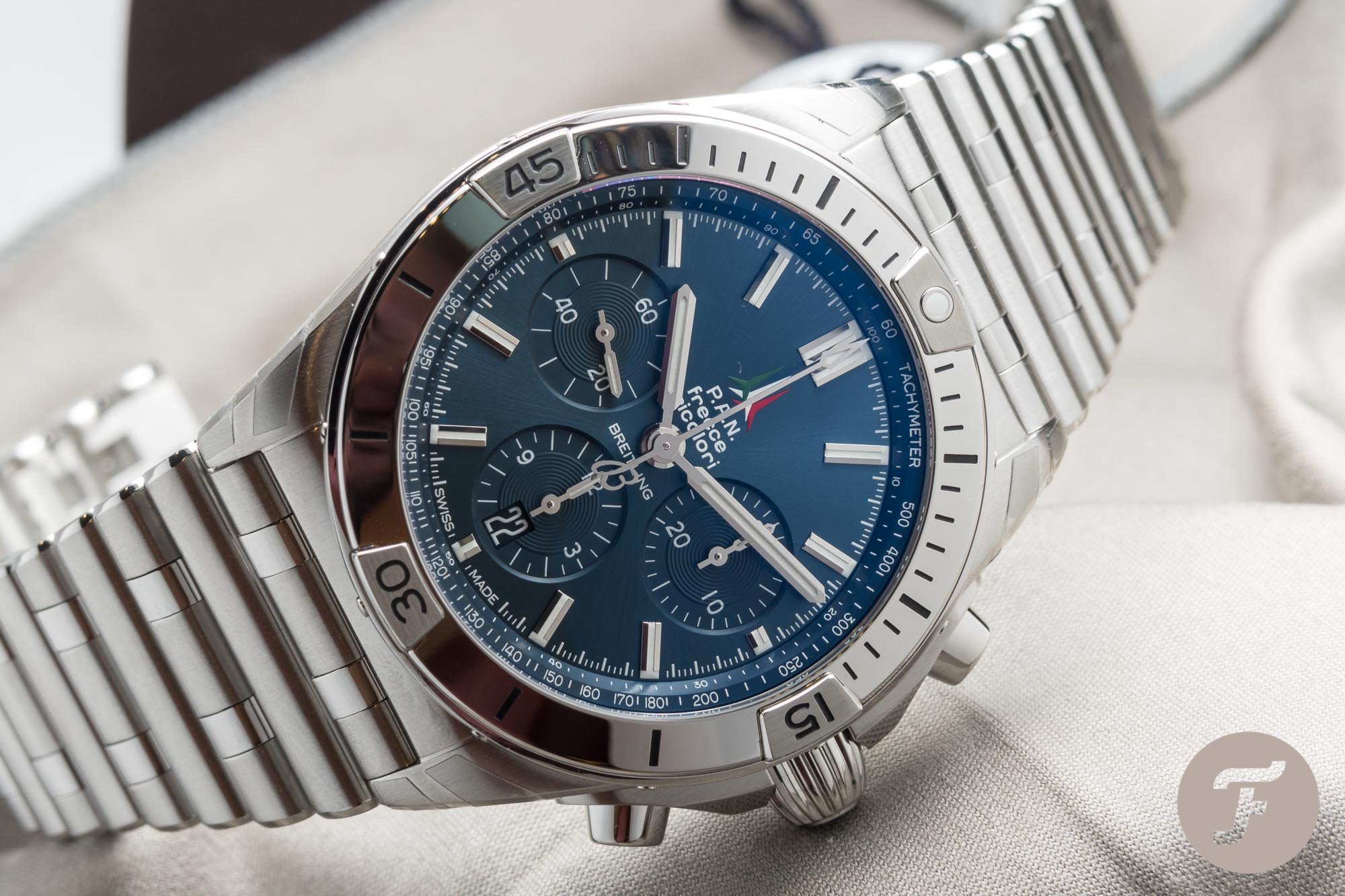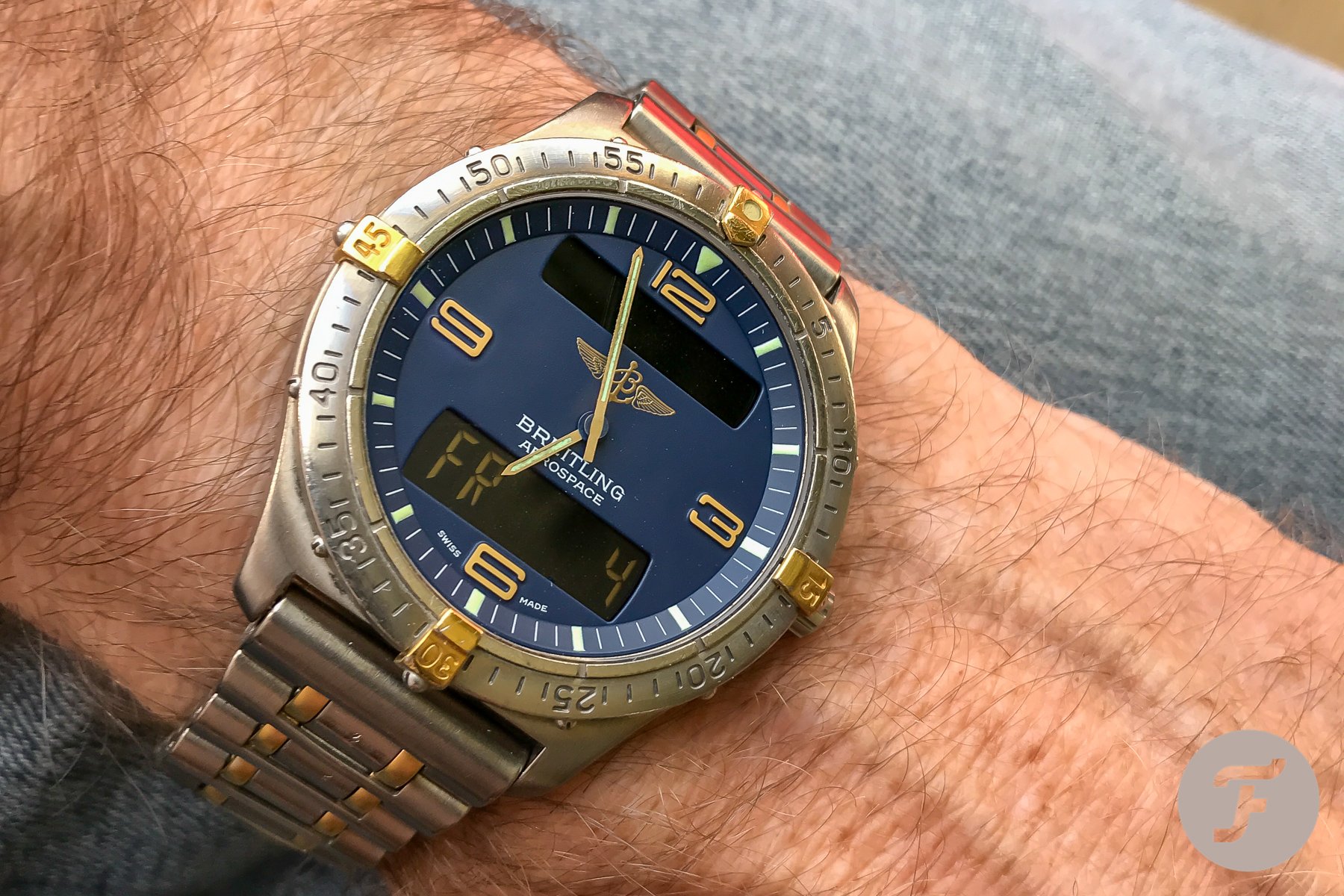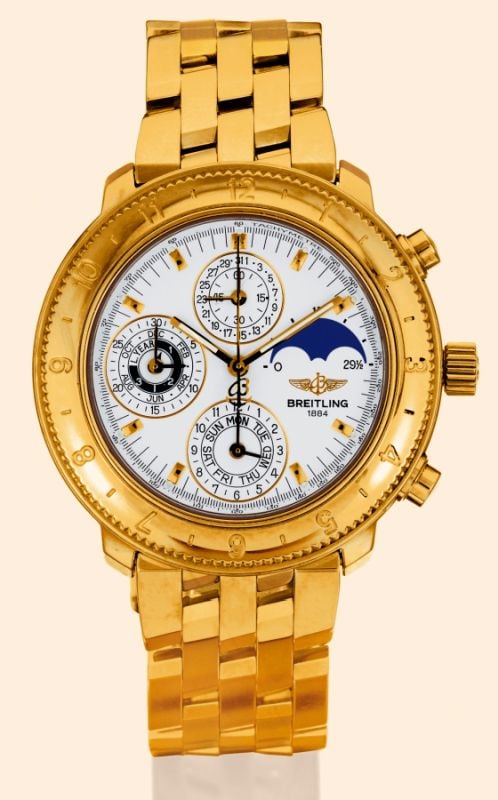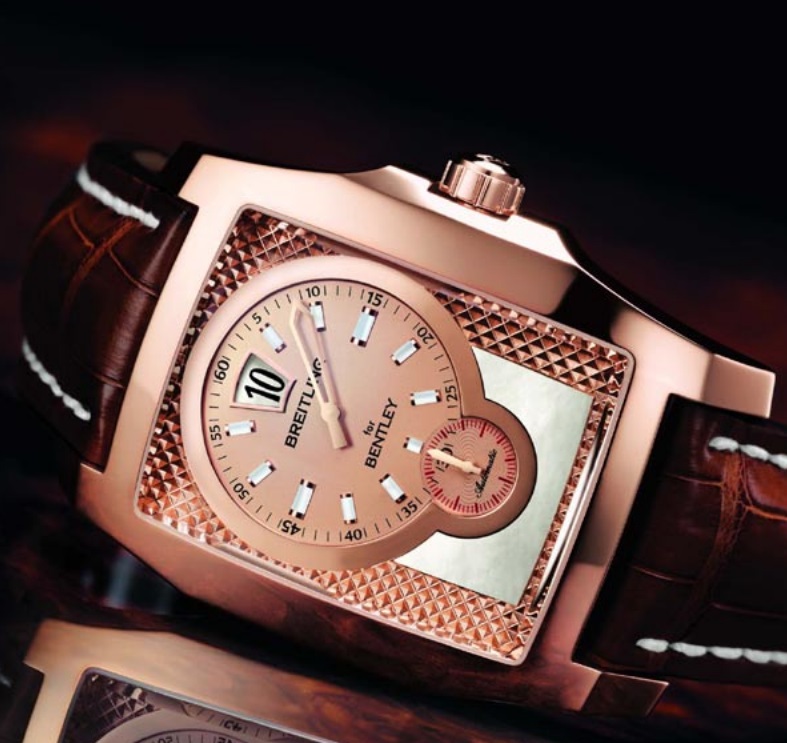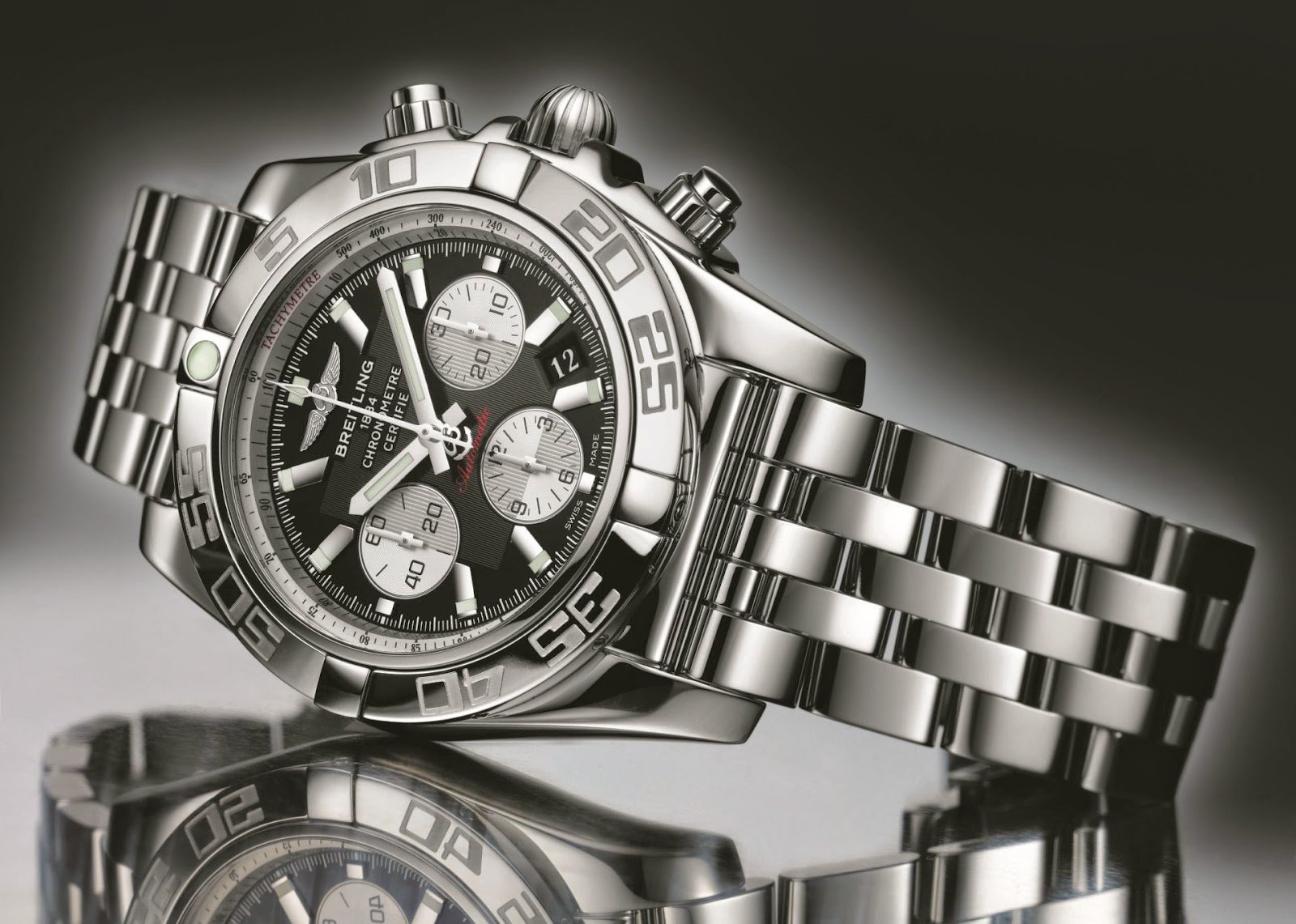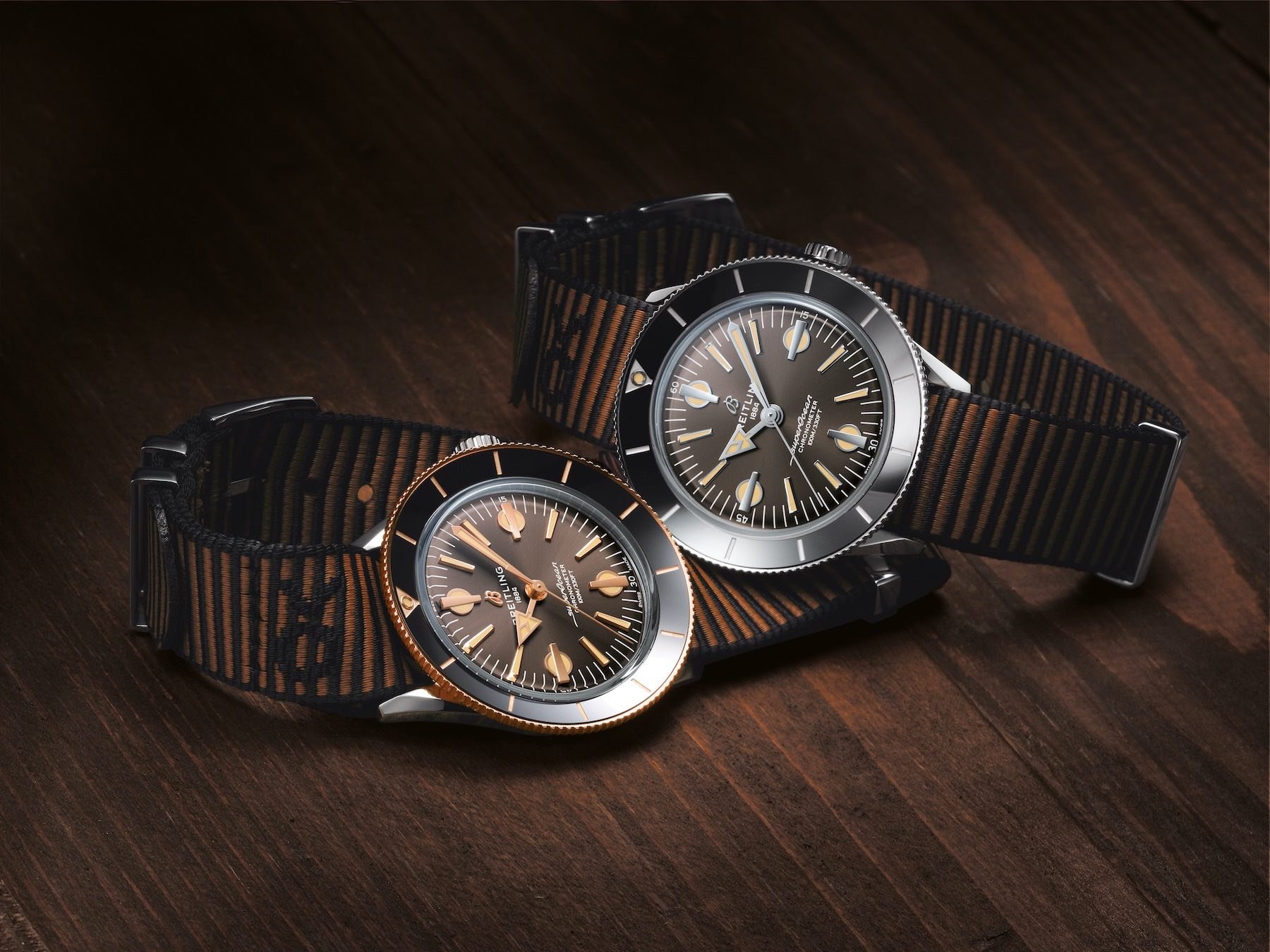A Brief History Of Time: Breitling’s Complete Brand History — Part Two: 1960–2021
Welcome back to another installment of a Brief History of Time. Today, we pick up where we left off, exploring the fascinating history of Breitling.
With the Chronomat and Premier in the ’40s and the Navitimer and SuperOcean in the ’50s, Breitling had built up some major momentum. The 1960s proved to be yet another fruitful decade for the brand, starting with some notable improvements to the Navitimer. The prior Navitimer’s all-black dial was changed to feature contrasting white subdials. This improved its legibility, and the new look also made it even more attractive to the mass market. The Navitimer thus became not simply a useful tool watch, but a popular symbol of class and style.
Then, in 1962, astronaut Scott Carpenter designed the Navitimer Cosmonaute. The watch featured a 24-hour dial, making it easy to distinguish between night and day in space. Carpenter, only the sixth human ever to fly in space, wore the Navitimer Cosmonaute in three orbits around Earth on May 24, 1962, aboard the Aurora 7 spacecraft. While many assume Omega made the first chronograph in space, the Breitling Navitimer preceded it by over four months. It was not until October 3 of that same year that Walter Schirra wore his Omega Speedmaster CK2998 into space.
A surge in popularity
In the ’60s, chronographs were becoming quite popular among young people. With a keen eye on appealing to this growing market, Breitling released the Top Time in 1964. Willy Breitling realized that younger people didn’t want the same type of watch worn by their fathers. Instead, as he put it, they wanted “a competition watch with special dials and push-buttons. A watch that will ‘impress the boys’ — a watch that is both impressive and really elegant.” Throughout its lifespan, the Top Time certainly delivered on these, becoming quite possibly the most trendy of the brand’s offerings. It was available in steel, gold-plated, or solid gold cases, with double or triple-register layouts.
The Top Time also featured a variety of dials. The “Zorro” dial, so named for the black mask-like frame that surrounds the chronograph “eyes”, has become a collector favorite. In 1965, a special Top Time in a custom square case graced the wrist of James Bond in the film Thunderball. The watch was equipped with a Geiger counter for detecting radiation, helping Bond locate stolen nuclear missiles and avoid catastrophe. As design trends evolved in the latter part of the decade, Breitling introduced a square Top Time in 1967. The watch was advertised in Harper’s Bazaar and appealed to both men and women as a valuable and fashion-forward accessory.
The race was on
As most watch enthusiasts are aware, the end of the 1960s marked an important event in the history of horology: the race to develop the first automatic chronograph. By the 1960s, convenient automatic watches had become very popular. Until that point, however, all chronographs had been purely manual-wind. Knowing they could either adapt or perish, many brands set out to be the first to bring a self-winding chronograph to market.
…Zenith, Seiko, and the “Chronomatic” alliance of Heuer, Hamilton-Buren, Dubois-Depraz, and Breitling.
Despite automatic chronographs being so prevalent today, in the 1960s, developing one was in fact no small feat. In the end, three major contestants were left in the running: Zenith, Seiko, and the “Chronomatic” alliance of Heuer, Hamilton-Buren, Dubois-Depraz, and Breitling. Although the latter four companies (especially Heuer and Breitling), were direct competitors, the potential bragging rights were very tempting. It was clear that all four of them could benefit from putting their heads together.
Project 99
The consortium worked secretly on what was known internally as “Project 99” for three years, resulting in the Caliber 11. The group then planned to debut it on March 3, 1969, at simultaneous press conferences in New York and Geneva. Much to the members’ chagrin, however, Zenith announced the El Primero caliber on January 10 of that same year. This movement was a fully integrated, column-wheel chronograph with a full rotor.
Zenith was indeed the first to announce its automatic chronograph. Which of the top three competitors can claim the bragging rights to the “first automatic chronograph”, however, remains a hotly debated topic. Opinions are often based on brand bias or selective definitions of “first”. At the end of the day though, the Chronomatic group was the first to produce a modular automatic chronograph with a micro-rotor.
Additionally, the group was able to release its Caliber 11 to worldwide retail markets by July of 1969. Zenith was not able to bring its El Primero to market until October of that year. Although Seiko released its automatic chronograph caliber 6139 in May of 1969, it was only for sale in Japan. Therefore, technically, Breitling and its teammates were indeed the first to bring an automatic chronograph for sale to the world at large. Breitling released the Caliber 11 in a rounded-case model called the Chronomatic, the Navitimer Chronomatic, and in the Chronomat itself.
The age of Astron
Not even the automatic chronograph in 1969, however, could stop the next blow to the Swiss watch industry. The very same year that Seiko released its own automatic chronograph, the Japanese watch giant also released the world’s very first quartz watch, the Astron. Several Swiss brands had been experimenting with quartz technology as well. In the early 1970s, Omega, Rolex, and even Patek Philippe introduced quartz models. Compared to their more affordable Japanese competitors, however, these models did not sell well.
Breitling also attempted to adapt to this rapidly changing market. The brand introduced several quartz models of its own, most notably, quartz Navitimers with LED and LCD displays. Breitling also continued to produce several of the mechanical and automatic watches that had made it popular. Its 1970s offerings included colorful, quirky, and very “of-the-period” releases in the SuperOcean, Top Time, Transocean, Datora, and of course, Navitimer lines. Sadly, these efforts were not enough to keep the company afloat. Willy Breitling, facing impending bankruptcy and poor health, therefore decided to liquidate the company’s assets.
The Sinn “Navitimer”
Before selling the brand as a whole, Breitling chose to sell assets related to the Navitimer to two other companies. All uncompleted stock, spare inventory, and design rights prior to the Navitimer’s 1979 production were sold to Zürich-based watch company Ollec & Wajs. That company went on to produce the watches under the brand name Aviation. Helmut Sinn purchased all completed stock and the rights to the Navitimer reference 806 and 809 designs. To this day, Sinn produces these “Navitimers” under full legal protection as Sinn’s own reference 903. Willy Breitling made the final sale of the Breitling name and trademarks to Ernest Schneider, a pilot and the proprietor of the Sicura watch company. Thus, after 95 years, in 1979, the Breitling legacy left the family and lay dormant until 1982.
Under new ownership
On November 30, 1982, Ernest Schneider registered the company under the name Breitling Montres S.A. and relocated the company’s headquarters to Grenchen. Despite the fact that quartz watches were dominating the market at the time, there were none yet with an analog chronograph display. In 1983, this prompted the aerobatic demonstration team of the Italian Air Force, the Pattuglia Acrobatica Nazionale Frecce Tricolori, to contact Breitling. They requested an analog chronograph that was not only rugged enough for the cockpit but also elegant and stylish enough to be worn on the ground.
A new design…
Schneider wanted to develop an entirely new design for these elite pilots. From his own experience, he knew that a pilot’s watch should be supremely comfortable. Thus, he gave the watch a 39mm case with short lugs and soft edges. Rather than a standard 60-minute timing bezel, Schneider added multifunctional “Rider tabs” at the 15, 30, 45, and 60-minute markers. The 15 and 45-minute tabs could be unscrewed from the bezel and swapped with each other. This allowed the wearer to choose between count-down or count-up functions. The tabs also made the bezel extremely easy to manipulate while wearing gloves, and they even served to buffer the crystal upon accidental impact. The watch featured a unique “rouleaux” bracelet with long cylindrical “bullet” links. As many Breitlings in this new era would also do, the watch utilized the rugged Valjoux 7750 automatic chronograph caliber.
The Frecce Tricolori loved the design, and Schneider knew he had a hit on his hands (or rather, his wrist). Therefore, in 1984, marking 100 years of rich heritage, Breitling released a design nearly identical to the Frecce Tricolori chronograph, the new Chronomat. The watch would serve as the rebirth of both the Breitling brand and the “cool factor” of the mechanical chronograph. The Chronomat became known not only as an instrument for pilots but as a mainstream symbol of fashion and style as well. Since 1984, the Chronomat and its myriad iterations have been mainstays in the Breitling lineup.
Instruments for professionals
In 1985, Breitling launched the Aerospace. This quartz watch featured an analog time display, two digital displays, a perpetual calendar, dual time zone, and chronograph function. Remarkably, the wearer could control all of these functions via the crown. 1985 also saw the rebirth of the legendary Navitimer, first in a Lemania-powered manual-wind variant, and in a Valjoux-powered automatic version in 1987. Not content to make watches for just the skies, but also the seas, Breitling also released their Diving and Super Compressor lines of water-capable timepieces. It was in the mid-1980s that Breitling adopted the now-famous (though currently “discontinued”) logo with the classic Breitling B, flanked by wings and fixed by an anchor. The logo symbolized Breitling’s commitment to producing serious timepieces that were capable in the most extreme conditions.
Though previously released in the late ‘80s, the Breitling Emergency was relaunched in 1995. It would become a true icon of professional timepieces. Constructed completely of titanium, the watch featured not only the ana-digi display popularized by the Aerospace, but also an emergency beacon capable of sending a directional distress signal up to 167km over the international distress frequency. Thanks to this capability, the Emergency would go on to reportedly save dozens of lives. Modern-day variants remain a staple in the Breitling catalog.
Throughout the ‘90s, as Breitling’s popularity surged once again, the brand released a nearly innumerable amount of models. The Colt, originally designed for the military in the ’80s, made its civilian debut in the ’90s. It became a popular entry-level offering for the brand throughout the next two decades. The SuperOcean also made its return in 1995 with a more modern case and a Rider tab bezel.
Not all “rough-and-tumble”
While many models during the 1990s were based on the Chronomat’s winning aesthetic, with rugged cases and Rider-tab bezels, there were some exceptions to this trend. The Astromat, with its nearly lug-less, doughnut-like shape, was a flashy statement piece. It was available in steel, two-tone, and fully gold versions, and offered on a highly polished bracelet. While some Astromats featured a standard Valjoux 7750, other variations even included a perpetual calendar. The Premier line, symbolizing elegance since its debut in the 1940s, also made its return as the Navitimer Premier. The watch in fact bore little resemblance to the Navitimer, as it lacked both a slide rule and a notched bezel. Nevertheless, it was a classy offering in a restrained 36mm case, equipped with an automatic ETA 2892-based modular chronograph.
In 1999, Breitling made a bold commitment to timekeeping accuracy when it announced that all of the movements in their timepieces would be officially certified by the COSC. This included both mechanical and quartz movements. Quartz calibers, particularly prone to deviations due to temperature, would be “thermocompensated”, and held to an average daily rate standard of +/-0.07 per day. Breitling was the first watch brand to commit chronometer certification across its entire line of watches.
Breitling in the new millenium
The 2000s were, in general, an era of large, bold, and highly-polished watches for the brand. Breitling was actually no stranger to producing large watches for its day. As far back as 1969, in fact, Breitling had brought a whopping 47mm Navitimer Chrono-matic to market. The brand revived this design, albeit in a smaller 44mm case, in 2006. Then, in 2008, the brand went all-in and bumped it up to a massive 49mm. The Avenger, a line of bold, functional timepieces equally capable on the wrist of pilots or divers, were available in cases ranging from 44 to 49mm as well. Collection staples such as the SuperOcean, the Chronomat, and of course, the Navitimer all saw myriad iterations both in case size and functions.
A partnership with Bentley
2002 marked the beginning of the brand’s ongoing partnership with Bentley. That year, the luxury car manufacturer commissioned Breitling to make a dashboard clock for the Continental GT. When Bentley won the title at the famous 24 Hours of Lemans in 2003, Breitling went on to produce the Lemans timepiece to commemorate it. The blossoming partnership spawned a line of modernly-sized timepieces with a Bentley-inspired aesthetic that continues to this day. Standouts from the 2000s in this collection include the Flying B, a rectangular watch featuring a jump hour complication, and the Mulliner, available only in precious metals and the only Breitling watch to feature a tourbillon.
The dawn of a new era
In 2009, just in time for the brand’s 125th anniversary, Breitling made a historic move. The brand launched its first completely in-house chronograph movement for a wristwatch, the B01. The caliber features a modern 70-hour power reserve, column wheel, and vertical clutch for smooth operation and continuous accuracy, and obligatory COSC certification. It also has a modular design, allowing for more straightforward maintenance of the chronograph mechanism itself. The brand debuted this movement the same year in its Chronomat 01 model. Since then, Breitling has featured it in all of its most famous chronograph models, and the caliber has become renowned as one of the most reliable mass-market chronograph movements in the industry today.
Balancing new and old
Throughout the 2010s, the brand continued production of many of its bolder, more modern lines, while also gradually making a transition back to more traditionally-styled pieces. In 2011, Breitling revived the Transocean line, and the popularity of similarly vintage-inspired pieces, such as the SuperOcean Heritage, became harder to ignore. Concurrently, Breitling also wanted to adapt to the ever-growing smartwatch market, releasing the Exospace B55 in 2015. This watch, based on the Aerospace layout with an ana-digi display, allowed the wearer to set the time, adjust time zones, and even set alarms via smartphone. The digital displays also notified the wearer of incoming text messages, emails, phone calls, and calendar notifications.
In 2015, Ernest Schneider passed away, leaving the brand to his son Théodore. Although the younger Schneider had already served as the brand’s director for years, by 2016, it became apparent that the historically family-owned watchmaker would benefit from outside assistance. That year, the Schneider family sold 80% of the shares of Breitling to CVC Capital Partners. The following year, they also sold the remaining 20%. In spite of massive shifts in industry and market dynamics, Breitling had remained family-owned and faithfully independent for 133 years. Despite its change in ownership, however, all was not lost for the brand.
In good hands
In 2017, CVC chose Georges Kern, former CEO of 14 years at IWC, to uphold the Breitling legacy. Since then, the brand has done a remarkable job of balancing its offerings. The Avenger, SuperOcean, and Professional lines strictly feature the brand’s largest, most modern, and “toughest,” designs. The Aviator 8, SuperOcean Heritage, Chronomat, Navitimer, and Premier collections are brimming with a plethora of fan-favorite releases that echo the traditional styling of the brand’s greatest historical hits. The Chronomat received a vintage facelift with a “bullet” bracelet and a case/bezel design very similar to the 1984 original. As of 2021, Breitling has also enthusiastically revived the Premier line. Within it, one will find many of the designs that made Breitling so distinctive in the mid-20th century. The“Zorro” dial Top Time, the B15 Duograph 42 with a manually wound movement, and the triple calendar moon phase B25 Datora 42 are all present.
Throughout its 137-year history, Breitling has persevered through multiple crises and market downturns. It has also been steadfast in its commitment to quality, reliability, style, and innovation. Under Georges Kern’s leadership, the brand upholds this commitment, balancing rugged, modern models with historically inspired classics. Even less than a decade ago, many watch enthusiasts questioned the brand’s direction. In 2021, however, it seems that skepticism is quickly vanishing. These days, Breitling has both a clear understanding of what it does best and the classics that made it great. With an ear tuned to enthusiasts’ desires, it has once again become a brand for watch lovers to get excited about. And if Georges Kern has anything to say about it, the hits won’t stop coming anytime soon. Learn more about Breitling here.

